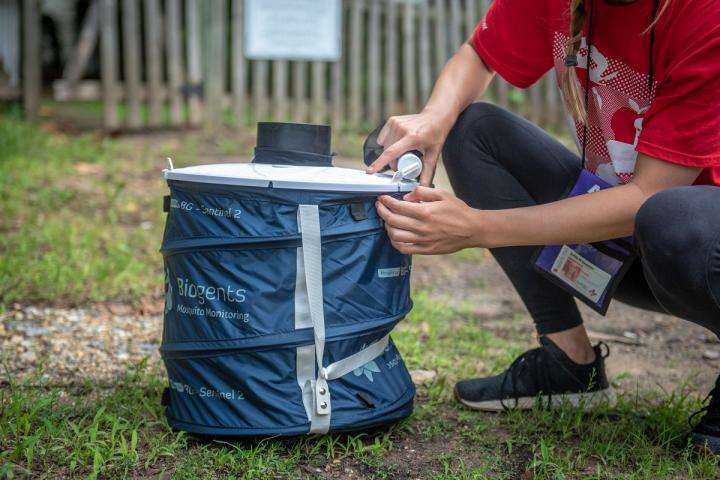Preliminary results point to a need for more research and education to improve environmental justice and protect urban public health in at-risk populations

Credit: Lena McBean, University of Maryland
In a new study published in the Journal of Medical Entomology, researchers at the University of Maryland (UMD) found higher rates of West Nile virus-infected mosquitoes in lower-income neighborhoods in urban areas of Baltimore, Maryland. Continuing a collaboration with the Cary Institute of Ecosystem Studies and building on previous work finding larger mosquitoes (which may be more likely to transmit disease) in lower-income neighborhoods, this preliminary data provides another piece of the puzzle pointing to higher risks of mosquito-transmitted diseases like West Nile virus in these neighborhoods already struggling with environmental injustices and poorer health outcomes. This paper points to a need for more research in lower-income communities to inform policy and programs that can protect the health of those most at risk.
“In order to effectively address environmental injustices, we have to understand where they occur and why,” says Sarah Rothman, doctoral student in Environmental Science & Technology at UMD and lead author of this paper. “Urban mosquito sampling often takes place in city parks or other areas where traps are easily accessible to personnel, but we need to ensure we are sampling for mosquitoes in neighborhoods that are diverse in socioeconomic status. Representative surveillance is the first step. Only after identifying where disease risk is actually greatest can we direct public health resources to communities that need them most.”
This study acts as a first step in addressing environmental justice, providing another important connection between lower-income neighborhoods and risky mosquito populations, according to Paul Leisnham, associate professor in Environmental Science & Technology at UMD. “A higher infection rate was shown in two species of mosquito, the invasive tiger mosquito and the northern house mosquito. In previous studies, we have shown that mosquito abundances and female body sizes, two other ecological parameters that promote virus transmission, are also larger in lower-income neighborhoods. Now we have introduced another piece of the puzzle pointing to higher risks in lower-income areas.”
Leisnham spends time interacting with locals in urban Baltimore through his research and Extension efforts, highlighting an important point for mosquito population growth that isn’t exactly intuitive: “Less trash, fewer mosquitoes.” Mosquitoes can surprisingly breed in an amount of water as small as what gathers in a bottle cap left outside in a shady area for four or five days. If the water gathers in a shaded container and isn’t infiltrating into the ground through managed stormwater practices, it can easily become a mosquito breeding ground that can produce hundreds of biting adults.
Cary Institute disease ecologist Shannon LaDeau, collaborator on the study, explains, “More people are living in cities. At the same time, many other species are also adapting to city living. Invasive species like the tiger mosquito increasingly thrive in temperate urban areas, living among us and fundamentally altering the risk of local disease emergence. People living in neighborhoods with abandoned infrastructure are more at risk, because tiger mosquitoes flourish in less managed landscapes.”
While the connection between vacant lots, more trash, and more mosquitoes is established, more research is needed to further connect these environmental injustices to higher infection rates in humans. “West Nile virus incidence in the human population is often underestimated,” says Rothman. “Most cases are asymptomatic, and mild symptomatic cases are easily confused with other illnesses that present similarly, like the flu. We are likely especially missing cases in underserved populations with reduced access to quality medical care. Since it’s hard to track the prevalence of West Nile virus in people, we suggest additional sampling of the virus in mosquitoes. Additional research could also help us figure out why we’re seeing patterns of higher mosquito infection rates in lower-income neighborhoods and how these patterns are affected by environmental factors such as weather.”
“It’s important, especially in populations from lower-income areas since they are often immunocompromised with other infections, including HIV and likely COVID-19,” adds Leisnham. “The CDC [Centers for Disease Control and Prevention] has reported that the U.S. is not prepared for mosquito and tick-borne risks based on local health agencies’ surveys.”
Rothman stresses the need for this work to improve environmental justice in lower-income areas of cities like Baltimore. “Our research supports the notion that residents in these neighborhoods are disproportionately at risk for mosquito-borne illness,” says Rothman. “We need additional research to understand and address the underlying factors, and ultimately protect urban residents.”
###
This paper, entitled “Higher West Nile virus infection in Aedes albopictus and Culex mosquitoes from lower income neighborhoods in urban Baltimore, Maryland,” is published in the Journal of Medical Entomology, DOI: 10.1093/jme/tjaa262.
Media Contact
Samantha Watters
[email protected]
Original Source
https:/
Related Journal Article
http://dx.




